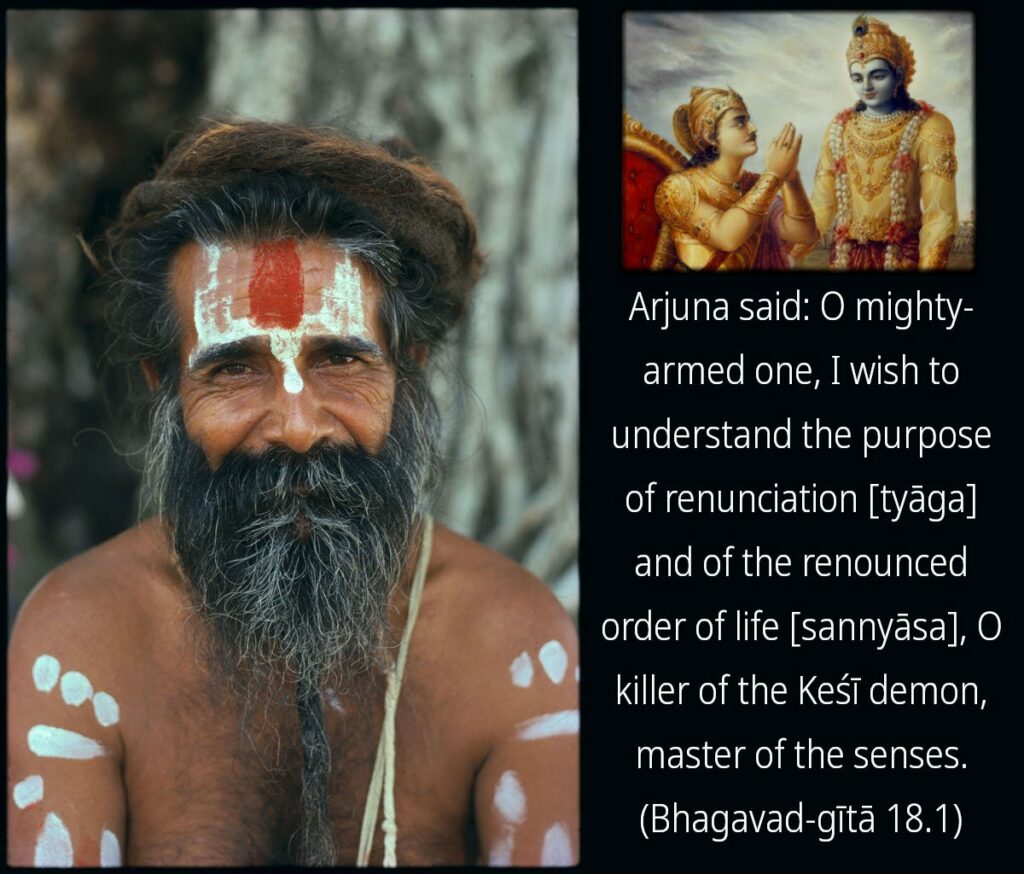अर्जुन उवाच |
सन्न्यासस्य महाबाहो तत्त्वमिच्छामि वेदितुम् |
त्यागस्य च हृषीकेश पृथक्केशिनिषूदन || 1||
arjuna uvācha
sannyāsasya mahā-bāho tattvam ichchhāmi veditum
tyāgasya cha hṛiṣhīkeśha pṛithak keśhi-niṣhūdana
arjunaḥ uvācha—Arjun said; sanyāsasya—of renunciation of actions; mahā-bāho—mighty-armed one; tattvam—the truth; ichchhāmi—I wish; veditum—to understand; tyāgasya—of renunciation of desires for enjoying the fruits of actions; cha—and; hṛiṣhīkeśha—Krishna, the Lord of the senses; pṛithak—distinctively; keśhī-niṣhūdana—Krishna, the killer of the Keshi demon
Translation:
Arjuna said: O mighty-armed! I desire to know what sannyasa is and what tyaga is, in essence. Tell me of them separately, O controller of the senses, the slayer of Kesi, Krishna!
Commentary:
In different contexts in the Gita, the Lord has used the word Sannyasa and Tyaga several times (3-30; 4-20; 4-41; 9-28; 12-6; 12-11; 12-12; 12-16; 14-25). But the two terms have not been explained distinctly. Hence Arjuna’s question.
In the Upanishads, the two concepts of Tyaga and Sannyasa are mentioned as means to liberation.
- Tyagenaike amrtattvamanusuh
- Samnyasayogad yatayas Suddhasattvah
Arjuna addresses the Lord thrice in different ways, revealing his high adoration for the Divine Teacher from whom he is learning the ultimate Truth. Such reverence for the teacher of Brahmavidya is essential for attaining spiritual illumination. The respectful questioning of Arjuna is what is known as pariprasna ‘; The proper way to approach the Guru, and place one’s doubts before him should be known by the disciple. Being pleased with such faithful devotion and reverence, the teacher showers his grace on the disciple and unravels the mystery of Divine Realisation.
Question: What is Arjuna’s question?
Answer: He desired to know from the Lord the distinction between Sannyasa and Tyaga in their essence.
Related Articles:
Bhagavad Gita: Chapter 18 🔻 (78 Verses)
| 01 | 02 | 03 | 04 | 05 | 06 | 07 | 08 | 09 | 10 |
| 11 | 12 | 13 | 14 | 15 | 16 | 17 | 18 | 19 | 20 |
| 21 | 22 | 23 | 24 | 25 | 26 | 27 | 28 | 29 | 30 |
| 31 | 32 | 33 | 34 | 35 | 36 | 37 | 38 | 39 | 40 |
| 41 | 42 | 43 | 44 | 45 | 46 | 47 | 48 | 49 | 50 |
| 51 | 52 | 53 | 54 | 55 | 56 | 57 | 58 | 59 | 60 |
| 61 | 62 | 63 | 64 | 65 | 66 | 67 | 68 | 69 | 70 |
| 71 | 72 | 73 | 74 | 75 | 76 | 77 | 78 |
